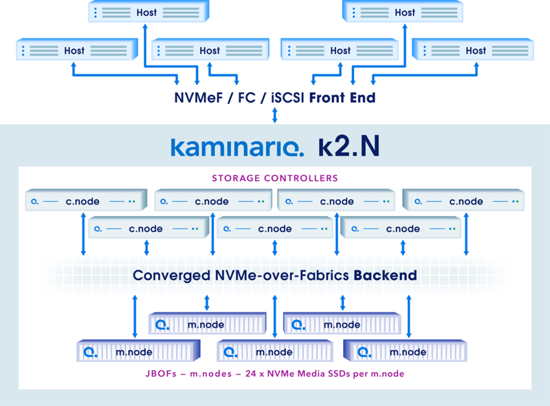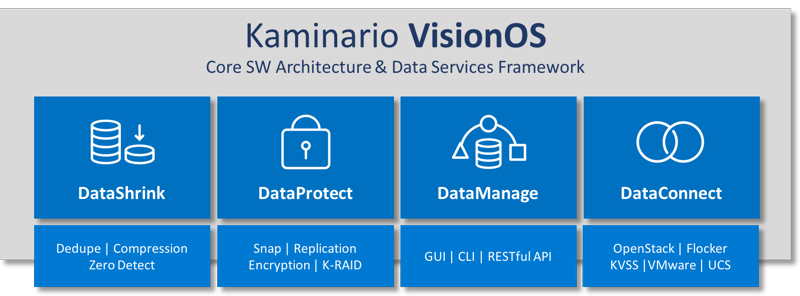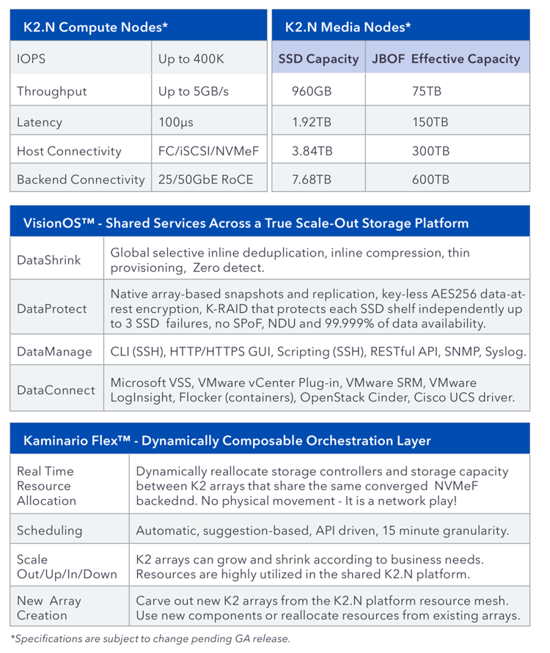Kaminario: K2.N All-Flash Storage Solutions Based on NVMe and Flex Software
Provide composable storage infrastructure delivering increased performance, scalability and agility for private cloud environments.
This is a Press Release edited by StorageNewsletter.com on August 18, 2017 at 2:42 pmKaminario Technologies Ltd. announced two products – K2.N and Flex.
K2.N is an extension of the company’s all-flash array platform leveraging the performance of emerging NVMe technologies and Flex is a platform for managing and orchestrating composable storage infrastructure.
“SaaS businesses and on-demand applications are driving the need for cloud-scale data center infrastructure optimised for advanced analytics, dynamic workloads and user experience,” said Eyal David, CTO, Kaminario. “Modern IT organisations are seeking storage solutions that can be optimised for specific applications while delivering the flexibility of the public cloud. K2.N and Flex leverage emerging NVMe technologies to deliver both increased performance and a new level of scalability and flexibility.“
The company was recently recognised by Gartner, Inc. for achieving the highest score for online transaction processing, analytics and HPC. These offerings build on firm’s established technology while leveraging the vast potential of NVMe and NVMe over Fabric (NVMeF).
K2.N: end-to-end, NVMe-based, all-flash array solution
leveraging proven enterprise software architecture and data services.
K2.N is a scale-out, active-active storage array with NVMe drives and a backend based on converged Ethernet and NVMeF. It supports NVMeF, FC and iSCSI front-end connections. Powered by key enhancements to VisionOS, K2.N supports the same set of enterprise data services as K2 Gen6, the company’s 6th generation all-flash array platform. This includes data reduction and native data protection features.
K2.N is comprised of controller nodes called c.nodes and media nodes (i.e. JBOF) called m.nodes that are connected via a shared NVMeF fabric. When customers purchase two or more c.nodes and any number of m.nodes, they can create a truly active-active, scale-out storage cluster with a shared data reduction space. It delivers new levels of shared storage flexibility without compromising on enterprise data services.
Additional features include:
-
No constraints on the ratio between c.nodes and m.nodes. With different types of c.nodes and m.nodes available, customers see optimised performance and capacity, and can scale their infrastructure according to business needs.
-
The K2.N is optimised for leveraging the low-latency NVMe interconnect delivering performance increases of more than 2x and performance density increases up to 4x.
-
Collaborative development with hardware technology suppliers including AIC, Broadcom, Brocade, Intel, Mellanox, and Supermicro.
Flex screenshot
Click to enlarge
Flex: software platform for managing
and orchestrating composable storage infrastructure
Flex is a storage orchestration platform for managing K2.N resources. K2.N together with Flex deliver enhanced operational efficiency and organisational agility. Customers will dynamically configure K2.N resources through the Flex dashboard, creating virtual private arrays (VPAs). VPAs have the same performance and capabilities as traditional arrays but can be dynamically scaled out or up at the orchestration layer – with no physical reconfiguration. The composable storage paradigm offers advantages over traditional array based architectures in building cloud-scale, shared storage infrastructure.
Additional features include:
-
Integration with VisionOS management utilities and the firm’s Claritycloud-based analytics environment.
-
Set of APIs for integration with application layer, data center orchestration, automation and ITIL software platforms.
The company believes that Flex and K2.N will form a new paradigm for managing shared storage resources. Individual arrays supporting different applications and business units draw from a shared resource pool on a shared fabric. New availability models emerge as hardware failures can be detected, replaced and provisioned all within the software. New tiering models materialise with the ability to dynamically move data from one tier to another with no physical reconfiguration. Performance sensitive analytics workloads can borrow additional controller compute to manage surge requirements and then return to the pool when no longer needed.
K2.N will be available in 1Q18. K2 will continue to be sold alongside K2.N through 2018 and beyond as the premium on NVMe based hardware technologies erodes. Flex will be available in 2H18.
Click to enlarge
“For an increasing number of real-time big data analytics and extremely high performance database environments, NVMe technology is already needed to meet latency, throughput, and/or bandwidth requirements. But Kaminario’s application of this technology to also offer composability with very high speed data mobility is an NVMe use case that is much more broadly applicable to a larger variety of workloads today,” said Eric Burgener, research director, storage, IDC.
“Kaminario’s K2.N demonstrates how fast the storage industry moves, just a year after the standardisation of NVMe over fabrics K2.N leverages NVMEoF’s to create an ultra-low latency scaleable storage fabric. Since K2.N extends Kaminario VisionOS to support NVMEoF customers don’t have to choose between networked NVMe’s performance and data services as they would with many of the start-up’s more limited or proprietary systems. With the addition of Kaminario Flex, K2.N will become a completely composable system allowing users to orchestrate controllers and NVMe JBOF storage dynamically into virtual arrays for almost unlimited flexibility and efficiency,” said Howard Marks, founder and chief scientist, Deepstorage.net.
“Kaminario has demonstrated leadership in leveraging NVMe and NVMe over Fabrics. The advancement of the software-defined K2 powered by VisionOS, now with NVMe SSDs, unified NVMe over fabrics, a new orchestration, automation and analytics layer is the Composable Storage of the future. K2.N and Flex will bring the agility of infrastructure-as-a-service environments coupled with extreme performance of shared accelerated storage to private- and hybrid-cloud data centers,” said Ben Woo, principal analyst, infrastructure and cloud, Neuralytix, Inc.
“We are proud to be chosen as the hardware partner for Kaminario K2.N and Kaminario Flex,” said Michael Liang, CEO, AIC, Inc. “Kaminario’s unique software architecture unleashes the full capabilities of AIC’s HA202I-PH, a 2U all-NVMe flash array dual-node server platform, accelerating its performance and activating its support of HA.“
“Broadcom is pleased to partner with Kaminario on their new K2.N product line with our industry leading RoCE enabled NetXtreme Ethernet NICs and Storage SoCs“, said Dan Harding, VP, marketing, compute and connectivity division, Broadcom Ltd. “The combination of our products provides Kaminario with scalability for storage back end utilising NVMe over Fabrics (NVMeF).“
“NVMe is the next evolution in high performance flash storage,” said Jack Rondoni, SVP, storage networking, Brocade Communications Systems, Inc. “Brocade is excited to work with Kaminario and the K2.N to showcase the capability of NVMe over FC for our joint customers who demand the best performance, highest availability and most scalable infrastructure for their growing application requirements.“
“The new Kaminario K2.N flash storage array leverages our RoCE technology in concert with Mellanox’s end-to-end Ethernet solutions,” said John Kim, director, storage marketing, Mellanox Technologies Ltd. “Our Ethernet solution provides hardware acceleration for RoCE and NVMe-oF and unlocks the maximum performance of networked flash storage.“
“As the leader in all-flash NVMe system technology, Supermicro is pleased to be working closely with Kaminario on their NVMe-based all-flash storage solutions,” said Don Clegg, VP, WW business development, Super Micro Computer, Inc. “With over 100 NVMe-based platforms in our X11 server and storage portfolio, Supermicro continues to push the innovation envelope for NVMe technology by developing systems with increasingly higher density and faster performance.“


















 Subscribe to our free daily newsletter
Subscribe to our free daily newsletter

